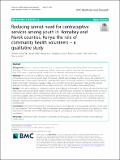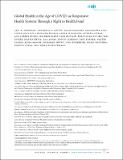Reducing unmet need for contraceptive services among youth in Homabay and Narok counties, Kenya:
| dc.contributor.author | Ormel, Hermen | |
| dc.contributor.author | Kok, Maryse | |
| dc.contributor.author | Smet, Eefje | |
| dc.contributor.author | Oele, George (Amref Health Africa,) | |
| dc.contributor.author | Oruro, Happiness (Amref Health Africa) | |
| dc.contributor.author | Oluoch, Beatrice (Amref Health Africa) | |
| dc.contributor.author | Indigo, Dorcus (Amref Health Africa) | |
| dc.date.accessioned | 2023-06-08T09:32:23Z | |
| dc.date.available | 2023-06-08T09:32:23Z | |
| dc.date.issued | 2021 | |
| dc.identifier.uri | https://repository.amref.ac.ke/handle/20.500.14173/837 | |
| dc.description.abstract | Abstract Background: Access to contraceptive services is a cornerstone of human well-being. While Community Health Volunteers (CHVs) promote family planning in Kenya, the unmet need for contraceptives among youth remains high. CHVs seem to pay little specific attention to the contraceptive needs of the youth. Methods: We conducted a qualitative study exploring the role of CHVs in increasing access and uptake of contraceptive services among youth aged 18–24 years in Narok and Homabay Counties, Kenya. We undertook 37 interviews and 15 focus group discussions involving CHVs, youth, community members, community leaders, youth leaders and health programme managers. Data were recorded, transcribed, translated, coded and thematically analysed, according to a framework that included community, CHV and health system-related factors. Results: CHVs often operated in traditional contexts that challenge contraceptive use among unmarried female and male youth and young married couples. Yet many CHVs seemed to have overcome this potential ‘barrier’ as well as reigning misconceptions about contraceptives. While private and facility-based public contraceptive services were somehow available, CHVs were the preferred service provider for many youth due to ease of access and saving time and transport costs. This was influenced by varied perceptions among youth of CHVs’ knowledge, skills and attitudes regarding contraceptives and provider-client interaction, and specifically their commitment to maintain confidentiality. Conclusions: CHVs have the potential to increase access to contraceptives for young people, reducing unmet need for contraceptives. Their knowledge, skills and attitudes need strengthening through training and supervision, while incentives to motivate them and broadening the range of contraceptives they are allowed to offer should be considered. | en_US |
| dc.language.iso | en | en_US |
| dc.publisher | BMC Health Services Research | en_US |
| dc.subject | Community health volunteers | en_US |
| dc.subject | Community health workers | en_US |
| dc.subject | Contraceptive services, | en_US |
| dc.subject | Family planning | en_US |
| dc.subject | Youth in Kenya | en_US |
| dc.title | Reducing unmet need for contraceptive services among youth in Homabay and Narok counties, Kenya: | en_US |
| dc.title.alternative | the role of community health volunteers – a qualitative study | en_US |
| dc.type | Article, Journal | en_US |
Files in this item
This item appears in the following Collection(s)
-
General - GEN [367]
This is a collection of research papers from the wider Amref community


